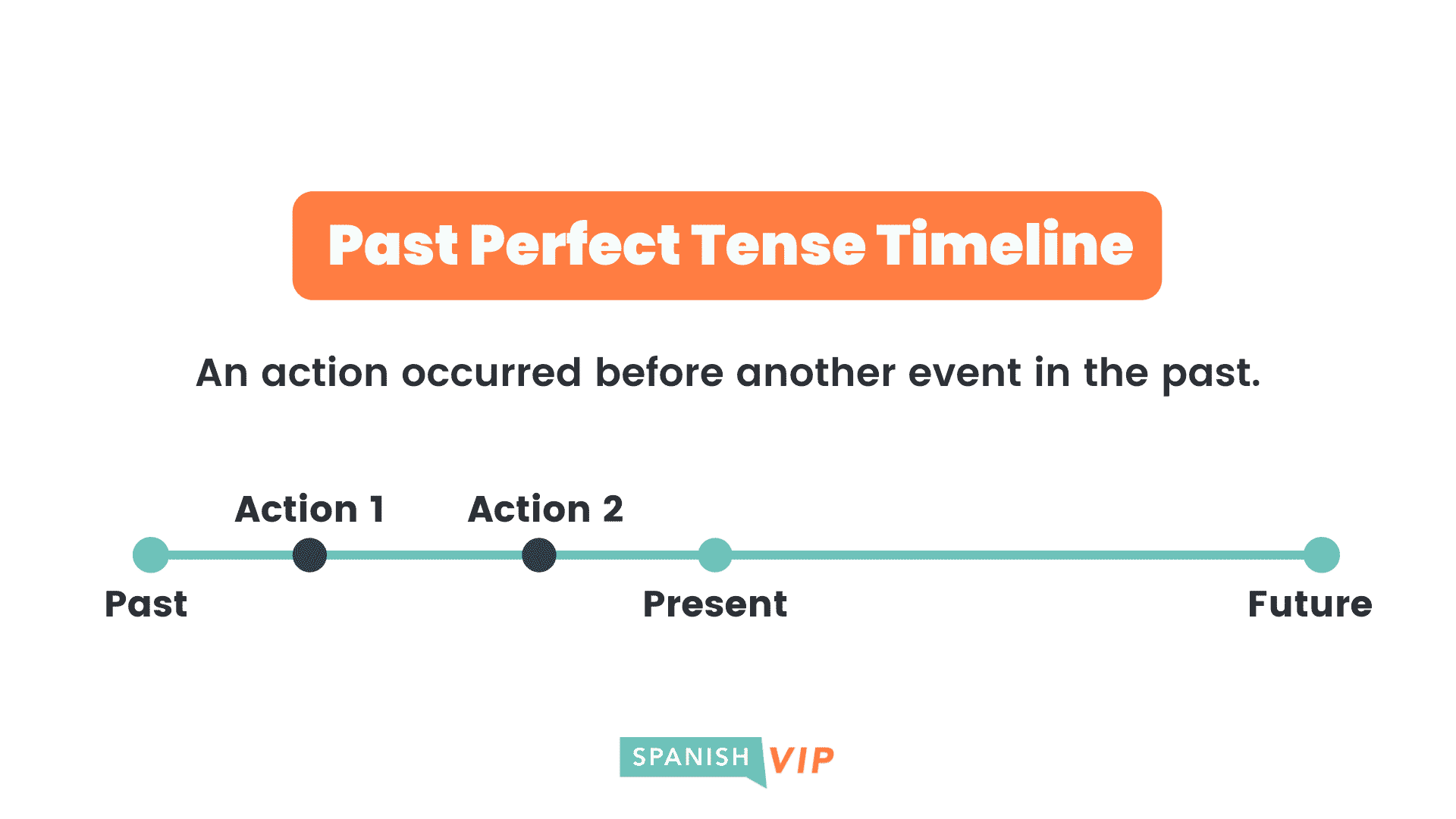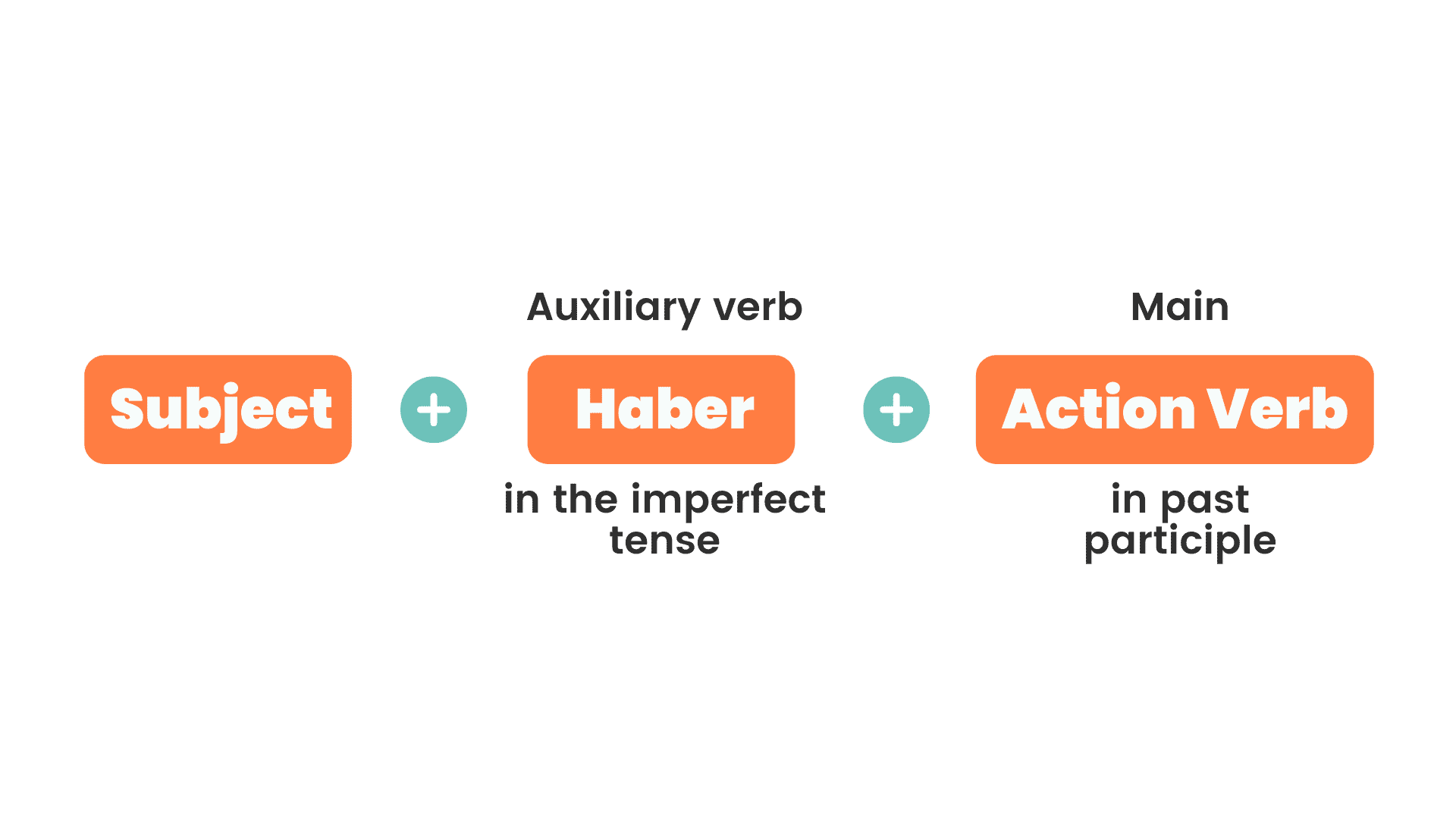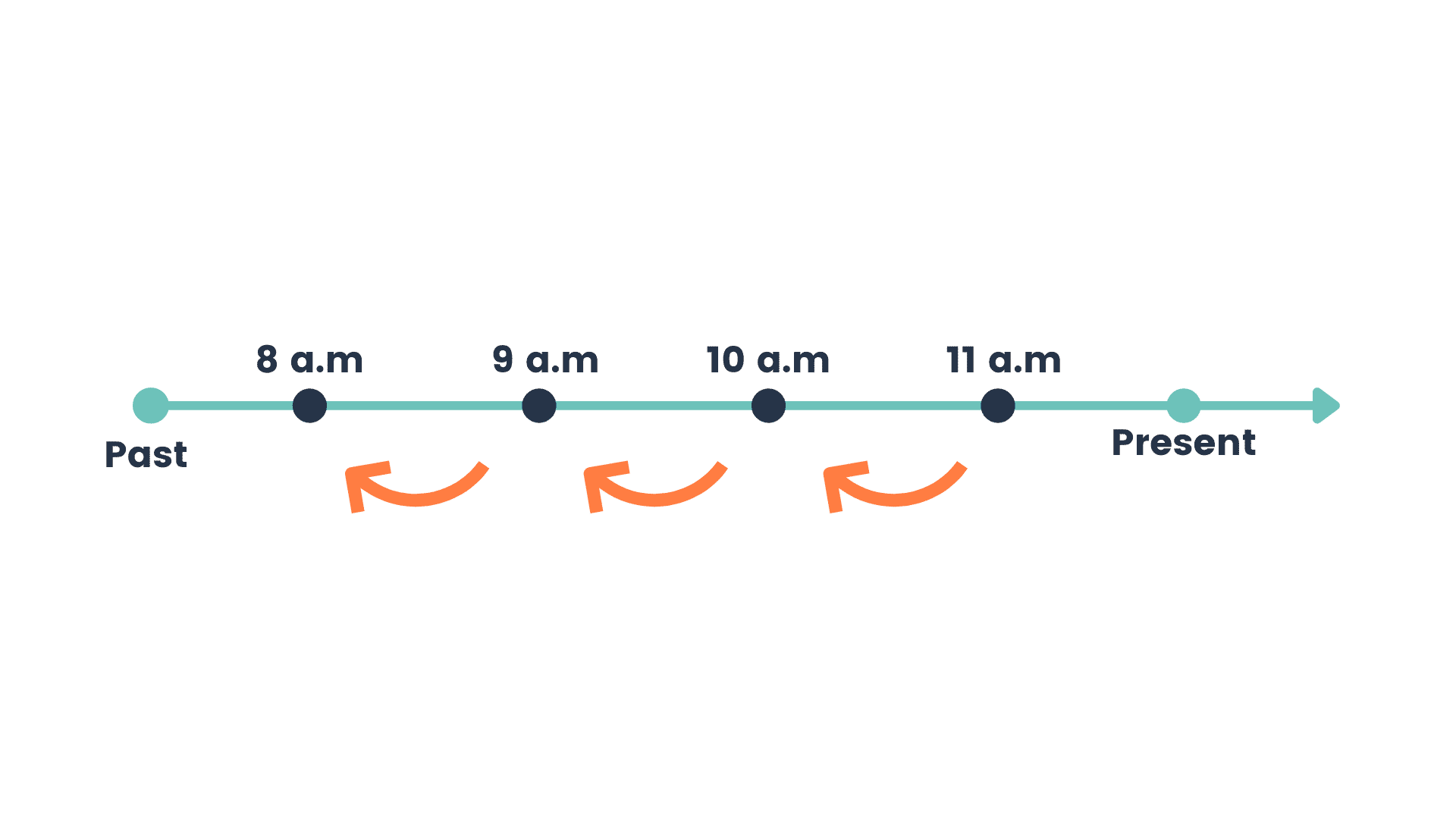
Past Perfect Spanish Tense Made Simple
DATE:
The past perfect Spanish tense or pluperfect, as in English, is used to talk about an action that had happened previously to another one in the past.
The past, again? Yes, as you may know by now there are five ways for expressing past events in Spanish and here we are going to break down for you the past perfect, also known as pretérito pluscuamperfecto.
The good news is that the Spanish past perfect tense is pretty much straightforward in form and use, because we don’t need to memorize a lot of grammar rules regarding verb conjugation and it has an English equivalent; it means that, opposite to the other four past tenses, the past perfect tense in Spanish is used in the same way as the English past perfect tense.
What is the Spanish past perfect tense?
As we mentioned before, the Spanish past perfect tense is employed when an action occurred prior to another action in the past.

To form a pluperfect sentence in Spanish we combine the verb haber in its simple past tense (imperfect past), used as an auxiliary verb, with the past participle of the main verb. For example:
- Carlos había comido mucho en el desayuno, por eso se sintió mal cuando corría en el parque – Carlos had eaten a lot for breakfast, that ‘s why he felt ill while running at the park.
Let’s break the Spanish grammar here down a bit.
In the past perfect tense, the auxiliary verb is going to be in the pretérito imperfecto (haber in the imperfect tense, había) and the main action verb in the past participle.

Conjugation of the auxiliary verb “haber”
In a past perfect tense sentence, the only verb that is conjugated in order to tell us who was doing the action is the auxiliary verb Haber alone, in its imperfect tense form, había. This verb works the same way as the verb had in English past perfect and this is how we conjugate it:
- Yo había
- Tú habías / Usted había
- Él/Ella había
- Nosotros habíamos
- Ustedes habían
- Vosotros habíais (used only in Spain)
- Ellos/Ellas habían
Perfect! Now, having covered the auxiliary verb, let us study the past participle for the main verb. Remember that the verbs in Spanish have regular and irregular form. We will start with the regulars because they are easier to memorize and are more abundant in number.
Spanish grammar rules for the use of past participle in the past perfect tense
Spanish past participle grammar rules for regular verbs
We categorize Spanish regular verbs in three types according to their endings, those who end in -ar verbs, -er and -ir verbs. In the table below we have some examples:
|
-Ar |
-Er |
-Ir |
|---|---|---|
|
Amar / To love |
Comer / To eat |
Salir / to go out |
|
Cantar / To sing |
Correr / To run |
Partir / to break |
|
Cocinar / To cook |
Morder / To bite |
Vivir / To Live |
To turn those verbs into past participles we follow these simple rules:
- For -ar verbs, we change the -ar for -ado. For example: Hablar → Hablado
- For -er and -ir verbs, we change their endings as well to add -ido instead. For example: Correr → Corrido, Salir → Salido.
Here are the verbs aforementioned in their past participle form:
|
-Ar |
-Er |
-Ir |
|---|---|---|
|
Amado / Loved |
Comido / Eaten |
Salido / Gone out |
|
Cantado / Sung |
Corrido / Run |
Partido / Broken |
|
Cocinado / Cooked |
Mordido / Bitten |
Vivido / Lived |
- Yo había trotado 4 km hasta que empezó a llover. – I had jogged 4 km until it started raining.
- Él/Ella había hablado tan bien de ustedes. – He/She had spoken so well of you.
- Cuando llegamos nosotros a la tienda, ya había cerrado. – When we arrived at the store, it had already closed.
Spanish past participle for irregular verbs
Unfortunately in Spanish, as in English, irregular verbs don’t follow a set pattern to form the past tense and past participle so you’ll have to learn them separately, and with constant use and practice they’ll be part of your vocabulary without you even noticing.
Here are the most common Spanish irregular verbs with their past participle conjugation:
|
Spanish Verb infinitive |
Spanish Past Participles |
English Verb infinitive |
English Past Participles |
|---|---|---|---|
|
Abrir |
Abierto |
Open |
Opened |
|
Cubrir |
Cubierto |
Cover |
Covered |
|
Devolver |
Devuelto |
Return |
Returned |
|
Escribir |
Escrito |
Write |
Written |
|
Hacer |
Hecho |
Do / Make |
Done / Made |
|
Resolver |
Resuelto |
Solve |
Solved |
|
Satisfacer |
Satisfecho |
Satisfy |
Satisfied |
|
Decir |
Dicho |
Say |
Said |
|
Descubrir |
Descubierto |
Discover |
Discovered |
|
Volver |
Vuelto |
Return |
Returned |
|
Imponer |
Impuesto |
Impose |
Imposed |
|
Morir |
Muerto |
Die |
Died |
|
Poner |
Puesto |
Put |
Put |
|
Romper |
Roto |
Break |
Broken |
|
Ver |
Visto |
See |
Seen |
Here are some examples on how to use them:
- Ustedes habían dicho que Juanito rompió el cristal pero Carlos ya confesó. – You had said that Juanito broke the glass but Carlos already confessed.
- Él había propuesto un plan de trabajo pero la decisión ya fue tomada por la gerencia. – He had proposed a work plan but the decision was already made by management.
- A decir verdad, no fuiste al cine porque tú habías visto esa película. – To tell the truth, you didn’t go to the cinema because you had seen that movie.
Also, there are just three verbs in Spanish that are the exception of the rule since you can conjugate them with either regular or irregular past participles. Depending on the place, people will use one or the other.
|
Spanish Verb |
Irregular Past Participles |
Regular Past Participles |
English Past Participle |
|---|---|---|---|
|
Freír |
Frito |
Freído |
Fried |
|
Imprimir |
Impreso |
Imprimido |
Printed |
|
Proveer |
Provisto |
Proveído |
Provided |
Uses of the past perfect tense in Spanish
In the real world, we use this tense when we need to tell stories and those stories describe a series of events that happened in the past. Let’s take a look at this example, a day in the life of Carlos:
- Carlos arrived home at 8 a.m.
- He had breakfast at 9 a.m.
- His brother told him the cat was sick at 10 a.m.
- He took his cat to the vet at 11 a.m.

If we are supposed to tell this story backwards, this is what we get:
- Carlos took his cat to the vet thanks to his brother who had told him it was sick.
- By the time his brother told him that the cat was sick, Carlos had already eaten his breakfast.
- Carlos was able to eat his breakfast at 9 a.m. because he had arrived home earlier.
In Spanish, it would be like this:
- Carlos llegó a su casa a las 8 a.m.
- Desayunó a las 9 a.m.
- Su hermano le dijo que su gato estaba enfermo a las 10 a.m.
- Carlos llevó a su gato al veterinario a las 11 a.m.
This is how we use the past perfect to tell Carlos early morning series of events backwards in Spanish:
- Carlos llevó a su gato al veterinario gracias a su hermano que le había dicho que estaba enfermo.
- Cuando su hermano le dijo que su gato estaba enfermo, Carlos ya había desayunado.
- Carlos pudo desayunar a las 9 a.m. porque había llegado más temprano a casa.
Examples with Past perfect tense
Remember that in Spanish some verbs are a little bit different in use and form from what you may be accustomed to in English, and some others are just the same. Take a look at the following examples:
Ser (to be)
- Ellos habían sido escogidos como candidatos antes de salir los resultados de sus pruebas. – They had been chosen as candidates before their test results came out.
- No había sido tan fácil salir de casa en cuarentena. – It had not been so easy to leave the house in quarantine.
- No había sido tan caluroso el verano en Europa hasta este año. – It had not been so hot the summer in Europe until this year
Also, in Spanish it’s very common to see the Ser verb used in impersonal negative sentences.
Estar (to be)
- Ella había estado enferma antes de llegar. – She had been sick before arriving.
Hacer (to do)
- Nosotros habíamos hecho nuestros deberes antes de que nos regañaran. – We had done our homework before we were scolded.
Hacer (to make)
- Ellos ya le habían hecho una torta a su mamá antes de hablar con ella. – They had already made her a cake before talking to her.
Escribir (to write)
- Tú me habías escrito un mensaje de texto anoche pero me quedé dormido – You had written me a text message last night but I fell asleep.
Ver (to see)
- Nosotros habíamos visto venir esos inconvenientes antes de avisarles. – We had seen these problems coming before we told you.
Tener (to have)
- Usted había tenido la oportunidad perfecta de participar en las olimpíadas como boxeador. – You had the perfect opportunity to participate in the Olympics as a boxer.
Saber (to know)
- Los trabajadores habían sabido de los despidos con tiempo de anticipación. – The workers had known about the layoffs well in advance.
The use of reflexive verbs and pronouns in the Past Perfect Spanish
In Spanish, reflexive verbs are conjugated with a reflexive pronoun (me, te, se, nos, os, se) that is consistent in person and number with the subject and is always placed before the auxiliary verb. For example:
- Me había leído el libro cuando salió la película. – I had read the book when the movie came out.
- Se había ido a jugar al parque sin darse cuenta que dejó la puerta de la casa abierta. – He had gone to play in the park without realizing that he had left the door to the house open.
Using object pronouns in Past Perfect Spanish
The Spanish direct object pronoun is a word we use instead of the noun to stand in for the person or thing most directly affected by the action expressed by the verb.
Direct object pronouns replace nouns when it is already clear who or what is being talked about, and save having to repeat it.
- José no se percató de su celular. Lo había dejado sobre la mesa. – Jose didn’t notice his cell phone. He had left it on the table.
The word Lo has a wide arrange of uses: as a direct object pronoun, definite article, and many more. Check out our guide to master Lo in Spanish like a native.
Past perfect Spanish vs Present perfect Spanish
The first main difference between these two tenses is in the form of the auxiliary verb haber (infinitive for present, imperfect for past). It’s the only structural change.
|
Present Perfect Spanish: |
Past Perfect Spanish: |
|---|---|
|
Subject + haber + past participle main verb |
Subject + había + past participle main verb |
The second difference is in purpose. We use the present perfect tense in Spanish to describe a past action where the moment or the number of times it happened is not provided.
- Miguel ha tenido varios problemas con sus vecinos. – Miguel has had several issues with his neighbors.
The example above does not tell how many times that person has issues with his neighbors or when exactly that happened. This tense in Spanish also implies that the problem started in the past but it still affects his present.
We use the past perfect in Spanish a bit differently, two events connected to each other happened in the past and are no longer in motion. One action finished when the other started.
- Cuando conocí a Miguel, ya había tenido muchos problemas con sus vecinos. – When I met Miguel, he had already had many problems with his neighbors.
What it means is that by the time I met Miguel, his problems with his neighbors had already finished.
Practice what you learned!
This covers all regarding the past perfect Spanish. Of all the past tenses you have to study in this language, we know that it isn’t an easy one to grasp but it sure will help you broaden your skills.
Practice the verbs you learned in this article with your Spanish friends. How many stories can you tell using the Spanish Past Perfect?
If you’re ready to take your skills to the next level, our team can support you. Try a free private class or 7-day trial to our group classes, and see why thousands of students trust SpanishVIP.








